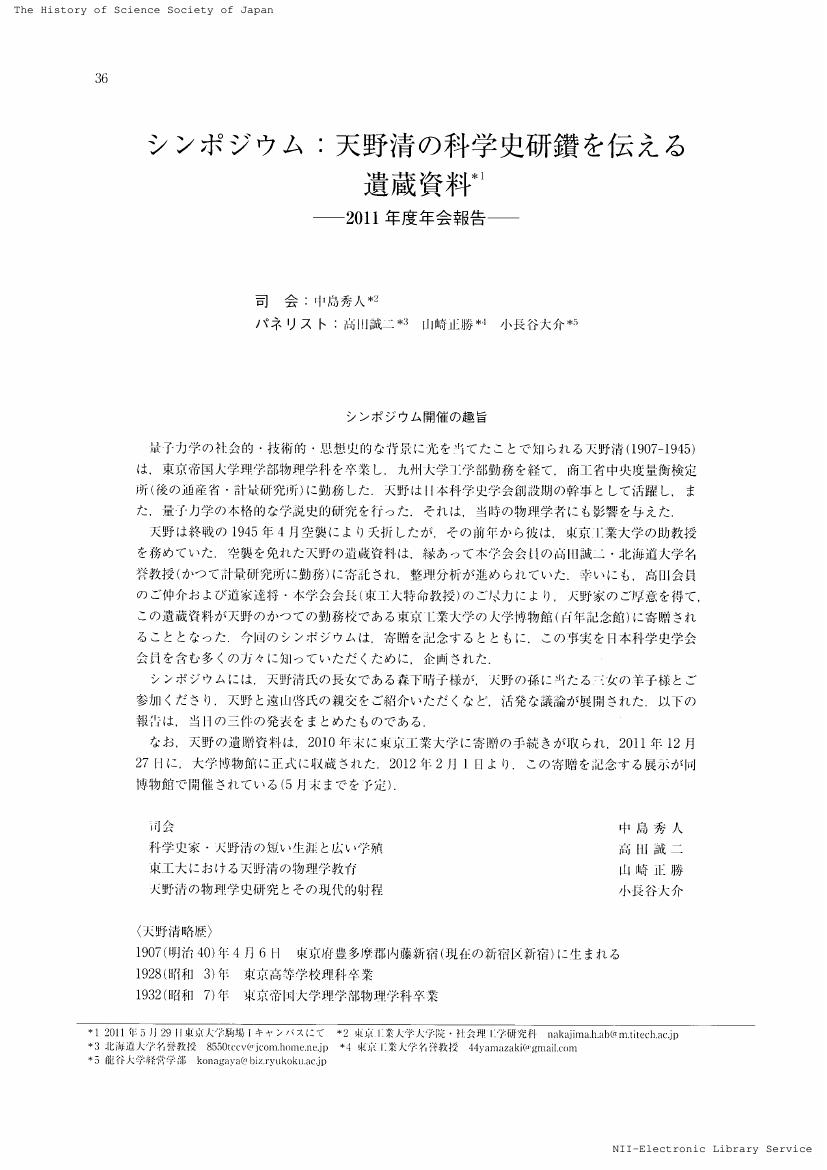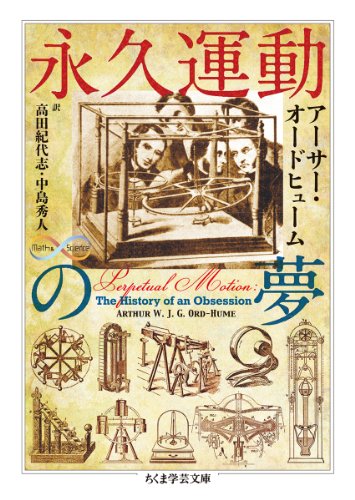12 0 0 0 OA 真実とエビデンス
- 著者
- 中島秀人
- 出版者
- 研究・イノベーション学会
- 雑誌
- 研究 技術 計画 (ISSN:09147020)
- 巻号頁・発行日
- vol.33, no.1, pp.2-5, 2018-03-31 (Released:2019-08-30)
In the foreword to the special feature, the author emphasizes the timeliness and importance of this volume. Against the impression of the title, articles in this volume warn the abuses of evidences. For example, Trump administration of US requests unnecessarily strict scientific evidences for the global warming. The lack of them is abused for the skepticism against scientific results. When we reflex the development of philosophy of science, it was not easy to identify ‘what evidences are'. It was, or still is, theoretically difficult to find out relevant ways to establish truth from evidences. We need to take critical and productive attitude on ‘truth and evidence' for the development of science policy studies.
1 0 0 0 OA マイケル・ポラニーの自然科学研究
1 0 0 0 OA 欧州における低エネルギー建築技術の発達
- 著者
- 詫間 直樹 中島 秀人
- 出版者
- 日本科学史学会
- 雑誌
- 科学史研究 (ISSN:21887535)
- 巻号頁・発行日
- vol.52, no.266, pp.81-91, 2013 (Released:2021-07-12)
The Fukushima Daiichi Nuclear Disaster has revealed the huge potential risk inherent in nuclear power generation. It adds very much to the existing energy problems such as depletion of fuels and global warming. To achieve substantial reduction in both fossil and nuclear energy, not only the enhancement of renewable energy on the supply-side but also the suppression of energy consumption on the demand-side would be required. Low-energy building technology is considered an effective means of energy consumption reduction. EU is the front-runner of this field, in terms of the level of technology, the adequacy of regulation, and the degree of diffusion. This implies that the development of low-energy building technology in Europe is worth historical study. With regard to historiography, we emphasize the complex nature of technological developments. It is not a linear, steady process. It turns and twists. A technological path is a result of aggregation of interactions - either conflicts or collaborations - among a variety of heterogeneous actors. Such complexity and heterogeneity often enrich the quality of technological development, according to the debates on the "resistance to new technologies " and the "unlocking of technological trajectories ". We also indicate some historical lessons such as the role of new entrants, the necessity of nurturing space for innovation, and the importance of sharing the basic concept of the technology among related actors.
1 0 0 0 OA シンポジウム:天野清の科学史研鑽を伝える遺蔵資料,2011年度年会報告
1 0 0 0 OA 1990年シンポジウム:STSの課題と現実
- 著者
- 中島 秀人
- 出版者
- 日本科学史学会
- 雑誌
- 科学史研究 (ISSN:21887535)
- 巻号頁・発行日
- vol.29, no.176, pp.254, 1990 (Released:2021-08-30)
1 0 0 0 永久運動の夢
- 著者
- アーサー・オードヒューム著 高田紀代志 中島秀人訳
- 出版者
- 筑摩書房
- 巻号頁・発行日
- 2014
1 0 0 0 永久運動の夢
- 著者
- アーサー・オードヒューム著 高田紀代志 中島秀人訳
- 出版者
- 朝日新聞社
- 巻号頁・発行日
- 1987
1 0 0 0 OA 望遠鏡と顕微鏡:イタリア・オランダ・イギリスとアカデミー
本研究は科学機器の歴史について、主に望遠鏡と顕微鏡に光をあて、イタリア・オランダ・イギリスのケースに加え、フランスの事例の研究を行った。この研究では哲学機器とも呼ばれた数学機器や、望遠鏡と四分儀を組み合わせた測地機器、また物理教育に使われた一連の力学機器などを検討したその際、科学機器自体の歴史を基礎に、科学の組織化、いわゆるアカデミーなどの制度化についても検討を行った。科学機器の歴史を通じて、科学史をより広く、また深い観点から検討するための基礎的な作業である。
1 0 0 0 IR 技術者の倫理と技術の倫理--ラングドン・ウィナーを出発点として
- 著者
- 中島 秀人
- 出版者
- 名古屋工業大学技術倫理研究会
- 雑誌
- 技術倫理研究 (ISSN:13494805)
- 巻号頁・発行日
- vol.5, pp.1-14, 2008
本稿では、ラングドン・ウィナーの「人工物の政治」という観点を批判的に発展させ、「技術者倫理」が「技術倫理」へとさらに展開されるべきことを論じる。古代において、プラトンやアリストテレスは技術と政治を相関するものと捉えた。だが、産業革命期にこの視点は失われ、技術、そして科学技術が人間を支配する傾向が生じた。さらに、冷戦によりリニア・モデルが優勢になると、人工物は必然的な知識としての科学の成果であるという理解がなされた。しかし、1980年代以降、リニア・モデルの限界が理解され始めた。近年では、科学を担う科学者だけでなく、技術者の役割の重要性が認知されるようになった。このような変化は、作られた人工物の社会的影響だけでなく、どのような人工物を作り出すのかを倫理的に検討する条件を生み出している。
1 0 0 0 ハンガリー出身の天才科学者たち(歴史の小径)
- 著者
- 中島 秀人
- 出版者
- 一般社団法人日本物理学会
- 雑誌
- 日本物理學會誌 (ISSN:00290181)
- 巻号頁・発行日
- vol.61, no.11, pp.840-842, 2006-11-05
- 著者
- 中島 秀人 MORENO-PENARANDA Raquel MORENO-PENARANDA Raqouel
- 出版者
- 東京工業大学
- 雑誌
- 特別研究員奨励費
- 巻号頁・発行日
- 2009
世界中の都市で人口が急増し、都市の面積が拡大している。都市外の生物多様性は犠牲となり、生物多様性の喪失や温室効果ガスの排出など、地球環境問題を悪化させている。食物を供給し、洪水やヒートアイランド効果を抑え、地域の福利に不可欠な物資やサービスを提供する、生態系の能力は見落とされている。近年になってようやく、ローカルおよびグローバルな観点から、地域の食システムを(再)構築する都市農業の潜在性が注目されるようになった。当研究は、日本の都市農業が持続性や福利にどの程度貢献しているかを検証し、また、都市農業と林業・漁業の繋がり、さらにはこれに対する地域、国、国際的ガバナンスの影響を検証した。日本は、都市圏で国内農業生産の1/4以上を供給する高度先進国であり、グローバルな持続可能性に貢献すると同時に、地域の農業の生態学的、社会経済的恩恵を得ている珍しい事例である。この研究では、持続可能な自然資源管理について、フィールド調査を中心として分析を加え、社会や生態系に関する学際的な理解を深めた。具体的には、生態系サービスと生物多様性を高める都市農業の生態系上の役割を調査し、それが都市のエコロジカルフットプリントをどの程度軽減するかを分析した。以上のコアプロジェクトに加えて、インドネシアにおけるバイオ燃料作物の持続可能性の研究、日本では、石川県金沢市の生物多様性について広範囲な調査を行い、沖縄では、沿岸地域の暮らしの影響評価にも関わった。具体的には、石油流出による沖縄の生物影響評価を利害関係者の認識の観点から調査し、インドネシアでは、パーム油拡大による生態学的、社会経済的影響についてのフィールド調査を実施した。



